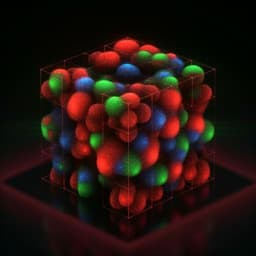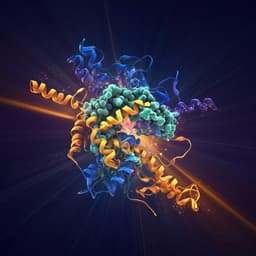
Chemistry
Sequentially amplified circularly polarized ultraviolet luminescence for enantioselective photopolymerization
D. Han, X. Yang, et al.
Discover groundbreaking research by Dongxue Han, Xuefeng Yang, Jianlei Han, Jin Zhou, Tifeng Jiao, and Pengfei Duan on a sophisticated system that showcases intense circularly polarized ultraviolet luminescence, setting the stage for chiral UV light-triggered enantioselective polymerization. This innovative approach merges excitation processes and reveals exciting applications for CPL-active materials.
~3 min • Beginner • English
Introduction
The study addresses the challenge of achieving circularly polarized luminescence (CPL) with large luminescence dissymmetry factors (glum) suitable for practical applications. Although CPL materials have potential in displays, sensing, and asymmetric photochemistry, most organic systems show small glum values and emissions largely confined to the visible region, limiting utility where higher photon energies are needed. Prior strategies to enhance glum include supramolecular self-assembly, aggregation-induced emission, energy transfer approaches, and incorporation into chiral liquid crystals, but strong circularly polarized ultraviolet luminescence (CPUVL) with high glum remains rare. The authors hypothesize that integrating triplet–triplet annihilation upconversion (TTA-UC) with CPL-active chiral emitters and further embedding in chiral nematic liquid crystals (N*LC) can sequentially amplify circular polarization into the UV, enabling functional applications such as enantioselective photopolymerization. They design a system using a chiral annihilator R-/S-4,12-biphenyl[2,2]paracyclophane (R-/S-TP) and an achiral TADF sensitizer (4CzIPN) to realize visible-to-UV UC-CPUVL and test whether the amplified UC-CPUVL can drive enantioselective polymerization of diacetylene.
Literature Review
The paper reviews that CPL-active systems typically exhibit small glum values (often 10^-4 to 10^-3 for small organic molecules), hindering real applications. Reported amplification strategies include supramolecular self-assembly, aggregation-induced emission (AIE), energy-transfer mediated circularly polarized excitation, and use of chiral nematic liquid crystals (N*LC), which can enhance CPL via optical rotation and circular dichroism. Upconversion via triplet–triplet annihilation (TTA-UC) is a low-power, efficient method to convert visible to UV light, relevant to photovoltaics, biomedicine, and photocatalysis. However, visible-to-UV TTA-UC examples are limited and often inefficient due to poor energy level matching between sensitizers and annihilators. Prior work showed TTA-UC can amplify CPL but typically only to glum ~10^-4–10^-3. Recent advances in TADF sensitizers (small ΔEST) improve intersystem crossing with less energy loss, offering better TTA-UC performance. The authors’ earlier study introduced upconverted CPL (UC-CPL), indicating potential amplification, motivating exploration of UC-CPUVL with higher glum by combining TADF-sensitized TTA-UC with chiral emitters and N*LC.
Methodology
- Materials and synthesis: The chiral annihilator R(S)-4,12-biphenyl[2,2]paracyclophane (R-/S-TP) was synthesized via Suzuki coupling of R(S)-4,12-dibromo[2,2]paracyclophane with 1,4-biphenylboronic acid, purified by column chromatography, and characterized by 1H NMR and MALDI-TOF-MS. The TADF sensitizer 4CzIPN was commercially sourced. The nematic liquid crystal host was 5CB.
- Prompt CPUVL in solution: Photophysical properties of R-TP (0.01 mM, THF) were measured: absorption bands at 255 and 290 nm; emission at 380 nm (λex = 290 nm). CD and CPL spectra were recorded for R-/S-TP (0.01 mM, THF), showing mirror-image CD and CPUVL with glum ≈ 3.1 × 10^-3 at ~380 nm.
- TTA-UC in solution: Due to better solubility in toluene, TTA-UC was studied in deaerated toluene with R-TP fixed at 3 mM and 4CzIPN varied; optimal at R-TP/4CzIPN = 3 mM/0.1 mM. Excitation used a 445 nm CW laser with a 445 nm short-pass filter to collect upconverted UV emission. Power dependence of UC emission intensity showed slope ≈ 2 at low power and ≈ 1 at high power, confirming TTA-UC; threshold intensity Ith = 75 mW cm^-2. Upconversion quantum efficiency ηuc reached 7.9% (standardized to 100% maximum using Coumarin 6 in DMF). Time-resolved UC emission at 385 nm had lifetime 84 μs. The 4CzIPN emission lifetime decreased from 149 to 34 μs upon adding annihilator, indicating efficient TTET.
- UC-CPUVL in solution: UC-CPUVL spectra were measured for R-TP/4CzIPN and S-TP/4CzIPN in deaerated toluene under 445 nm excitation; glum increased from 3.1 × 10^-3 (prompt CPUVL) to 9.2 × 10^-3 (UC-CPUVL).
- CPUVL and UC-CPUVL in N*LC: R-TP was doped into 5CB at various weight fractions to induce N*LC; optimal glum achieved at 10 wt% R-TP/5CB. Fingerprint textures confirmed N*LC formation; adding 4CzIPN preserved textures. CPL signal handedness followed the N*LC handedness (R-TP induced right-handed, S-TP left-handed). For UC-CPUVL, mixtures with R-TP/5CB = 10 wt% and 4CzIPN/R-TP ≈ 3 mol% were excited at 445 nm CW; UC-CPUVL glum reached ~0.19–0.20. UC intensity in N*LC was lower (Φuc ~2.3%), attributed to poorer dispersion of sensitizer/annihilator in LC.
- Enantioselective photopolymerization setup: A quartz cell (0.1 cm pathlength) containing R-TP/4CzIPN/5CB (R-TP/5CB = 10 wt%, [R-TP]/[4CzIPN] = 30/1) was argon-purged and excited with a 445 nm CW laser. A 445 nm short-pass filter was placed after the sample to block excitation light. A quartz plate coated with 2,4-nonadecanediynoic acid (NA) spin-coated film was placed behind the sample to receive UC-CPUVL. After minutes of exposure, NA polymerized to blue polydiacetylene (PDA). CD spectra of PDA were recorded; LD was measured to exclude artifacts. Photopolymerizations were repeated in 10 batches for statistics of gcp at 640 nm.
- Instrumentation: UV-vis (Hitachi U-3900), fluorescence (F-4500), CD (JASCO J-1500), CPL/UC-CPUVL (JASCO CPL-200, external 445 nm laser), lifetimes (Edinburgh FLS-980), upconverted emission spectra (Zolix Omin-1500i with PMT, 445 nm laser), POM (Leica DM2700M).
Key Findings
- Prompt CPUVL in solution: R-/S-TP exhibited CPUVL at ~380 nm with glum ≈ 3.1 × 10^-3 (THF, 0.01 mM, λex = 290 nm), with mirror-image signals for enantiomers.
- TTA-UC performance in solution (toluene, deaerated, R-TP 3 mM, 4CzIPN 0.1 mM): Visible-to-UV upconversion achieved under 445 nm CW excitation; power dependence confirmed TTA-UC with Ith = 75 mW cm^-2; upconversion quantum efficiency ηuc ≈ 7.9%; UC emission lifetime ≈ 84 μs; 4CzIPN lifetime shortened from 149 to 34 μs upon TTET.
- UC-CPUVL in solution: glum increased from 3.1 × 10^-3 (prompt) to 9.2 × 10^-3 (UC), approximately threefold amplification due to TTA-UC.
- CPUVL and UC-CPUVL in N*LC (5CB): Optimal dopant level at 10 wt% R-TP in 5CB maximized CPL. Prompt CPUVL in N*LC reached glum ≈ 7.5 × 10^-2. UC-CPUVL in N*LC achieved glum ≈ 0.19–0.20, about three times larger than prompt CPUVL in N*LC and 20–60 times larger than in dilute solution. UC quantum efficiency in N*LC was lower (Φuc ~2.3%). CPL handedness consistently followed the N*LC handedness.
- Enantioselective photopolymerization: UC-CPUVL generated from R-TP/4CzIPN/5CB under 445 nm excitation triggered polymerization of NA to PDA, producing mirror-image CD spectra depending on the UC-CPUVL handedness (R vs S). Statistical analysis across 10 batches showed consistent control of PDA chirality; the CD sign (e.g., at 640 nm) followed the annihilator enantiomer. The process exhibited good stability and repeatability.
Discussion
The research demonstrates that sequential amplification—first via TTA-UC from chiral annihilators sensitized by a TADF donor, then via embedding in a chiral nematic liquid crystal—can elevate circular polarization of UV emission to glum ≈ 0.19–0.20. This addresses the longstanding issue of low glum in organic CPL systems and extends strong CPL into the UV, enabling higher-energy photochemical applications. The TTA-UC mechanism contributes both photon upconversion and an intrinsic amplification of circular polarization, while the N*LC environment further boosts dissymmetry through chiral photonic effects. The resulting UC-CPUVL is sufficiently intense and highly circularly polarized to induce enantioselective photopolymerization of diacetylene, with chirality of the product controllably dictated by the handedness of the UC-CPUVL. Although UC efficiency in N*LC is reduced due to dispersion challenges, the high glum compensates for practical chiral induction, evidencing functional utility of UC-CPUVL for asymmetric photoprocesses.
Conclusion
The study introduces a visible-to-UV upconverted circularly polarized UV luminescence (UC-CPUVL) platform using chiral R-/S-TP annihilators and a TADF sensitizer (4CzIPN). It achieves efficient TTA-UC in solution (ηuc ≈ 7.9%, Ith = 75 mW cm^-2) and demonstrates substantial amplification of circular polarization: from glum ≈ 3.1 × 10^-3 (prompt) to 9.2 × 10^-3 (UC) in solution, and up to ~0.19–0.20 in chiral nematic liquid crystals. Crucially, the UC-CPUVL enabled enantioselective photopolymerization of diacetylene with reliable stereocontrol. These results provide a proof-of-concept for leveraging TTA-UC to generate highly circularly polarized UV light for asymmetric photochemical applications and broaden the functional scope of CPL-active materials. Future work could focus on improving dispersion and UC efficiency in liquid crystal hosts, optimizing energy level matching and concentrations, and extending the approach to other chiral reactions and device architectures.
Limitations
- The upconversion quantum efficiency in the nematic liquid crystal matrix was relatively low (Φuc ~2.3%) despite high excitation power, likely due to poor dispersion of sensitizer/annihilator pairs in the LC host.
- Excessive chiral dopant loading can alter LC host properties (e.g., increased viscosity, lowered clearing point), necessitating optimization around 10 wt% for best CPL.
- The approach relies on deaerated conditions for efficient TTA-UC in solution; oxygen quenching could limit performance in ambient conditions unless mitigated by encapsulation or barrier strategies.
Related Publications
Explore these studies to deepen your understanding of the subject.







